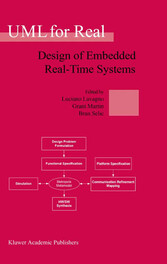Search and Find
Service
Chapter 13 Automotive UML
A (Meta) Model-Based Approach for Systems Development
Reconciling the Needs of Automotive Software Development with Model-Based Approaches (p.272-273)
Along with the evolution of the complexity of automotive embedded systems, the development processes of car manufacturers have been redefined to large degree. In the very beginning, electronic functions were developed in isolated development teams at the manufacturer’s site. As long as these functions had to fulfill a truly isolated task, the corresponding development processes were localized, i.e. easy to control and to maintain. However, with the increasing number of functions and the increasing number of interactions resulting in complex communication protocols the integration task for these functions failed due to insufficient support provided by the actual local development process in use. As a result severe technical problems such as incorrect feature interactions and timing latencies emerged. This lead to the well known symptoms of the "software crisis": blown budgets, late delivery, and unfulfilled requirements.
To overcome these difficulties one has to take into account the specific needs of a distributed development of automotive systems leading to a truly delocalized development process. Accordingly, the obtained development artifacts have to be communicated properly across the different development teams on a regular basis in order to gain an understanding of mutual dependencies between subsystems. Unfortunately, most developed systems lack well defined documentation, so that typically just the source code of realized functions would be exchanged. However, this is not sufficient to achieve a deeper understanding of the system’s functionality. Abstract models that could help to constitute an improvement were hardly ever used.
The complexities of a distributed development scenario were reinforced when third party suppliers took over the development of parts and components. In addition to the evolving deficiencies during the integration of those components into existing systems, car manufacturers complained about a progressive lack of knowledge of their own systems.
About 15 years ago, model-based techniques [17] were employed with great expectations to overcome the recognized difficulties of current development processes. Whereas in "traditional" engineering disciplines such as electrical and mechanical engineering, model-based techniques, like CAD (Computer Aided Design), FEM (Finite Element Method), and hardware design tools were employed with enormous success, a discipline called "software engineering" was hardly established. Since then various tools supporting visual modeling languages, configuration management tools, requirements management tools, and test tools were brought in, but the great diversity of model-based techniques, their abstract nature, and the strict focus of these tools on usually just one aspect of the development process limited their success and effectiveness within the actual development environment. As a consequence, car manufacturers started expensive integration projects to realize a model-based approach with the goal to achieve a seamless development process technically supported by a tailored tool chain.
Step by step car manufacturers developed a new perception of their systems’ architectures [4]. Nowadays, the partitioning of the system’s architecture into different abstraction levels, introducing a domain specific terminology, concepts for the formation of variants, and the understanding of model-based configurations seem to be potential steps towards a successful deployment of model-based techniques. In order to achieve a comprehensive and tightly-bound model-based paradigm for the automotive domain, only a well defined so called "metamodel-based" approach can be successful (cf. Section 1.3).
The AML includes abovementioned issues of a rigorous metamodelbased approach to simultaneously cover all different aspects of the heterogeneous system development needs within the automotive domain by providing a common conceptual framework.
All prices incl. VAT













